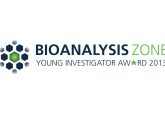2014 Young Investigator Finalist: Casey Burton


Nominee:
Nominated By:
Supporting Comments:
What made you choose a career in bioanalysis?
For nearly 25 years, I have been continually inspired by a dear friend and her six victories over breast cancer. While her story is certainly admirable, she shares her fight with millions of other cancer victims whose struggles could have been prevented through earlier cancer detection. With a fascination in biochemistry and bioanalysis, I realized that I had the capacity to save lives by pursuing those interests to develop novel diagnostic technologies for emerging cancer biomarkers. I have since dedicated myself to the bioanalytical field as a means of achieving earlier cancer detection and ultimately improving the human condition.
Describe the main highlights of your bioanalytical research, and its importance to the bioanalytical community.
My research aims at the development of highly robust, specific, and sensitive bioanalytical methodologies and diagnostic technologies to aid clinical validation and screening of emerging cancer biomarkers. Signaling a shift from traditional genomic and proteomic bioanalysis platforms, my work focuses on the emerging metabolomic field, and in particular, noninvasive urinary metabolomics, as a means to provide a more comprehensive, real-time assessment of disease stage and progression. The diverse chemical nature of metabolites has enabled detection by a variety of instrumental platforms and techniques, which a review of my work details the stunning versatility metabolic analyses offer to clinical practitioners. Specifically, I have developed independent analyses for sarcosine, alanine, creatinine, and eight clinically important pteridines using enzymatic fluorescence, LC–MS/MS, and CE-LIF instrumental platforms. Notably, my work with sarcosine involving enzymatically-induced pH changes that may be sensitively detected by fluorescein has provided a powerful assay for a wide variety of additionally useful biomarkers with specific oxidase enzymes. In addition, my LC–MS/MS methodology for urinary pteridines has enabled clinical trials to reliably validate pteridines as possible cancer biomarkers. Finally, my contributions to proposing novel urine concentration-dilution normalization factors, such as urine specific gravity, carry significant transformative potential to the bioanalytical field.
Describe the most difficult challenge you have encountered in the laboratory and how you overcame it.
The novel enzymatic determination of sarcosine presents perhaps my most unique and challenging research problem. The method was originally developed to detect reactive oxygen species (ROS) byproducts from the specific enzymatic oxidation of sarcosine by sarcosine oxidase using a ROS-sensitive fluorescent probe. The high specificity of sarcosine oxidase provided a means to resolve sarcosine from its isomer, alanine, which is typically present at much higher concentrations in urine. Despite being theoretically straightforward, I consistently failed to generate a relationship between sarcosine concentration and experimental fluorescence. After meticulously redesigning and repeating the study I finally observed a weak inverse relationship. Now knowing an interference was limiting the ROS-induced fluorescence, a simple review of the enzymatic oxidation scheme revealed that another byproduct, formic acid, produced at equimolar rates, was deactivating the fluorescein derivative. I quickly redesigned the method to take advantage of this pH-induced fluorescence by measuring instead the loss of fluorescence as formic acid was generated. By performing the assay at slightly alkaline conditions at body temperature, the hydrogen peroxide byproduct was automatically eliminated as oxygen gas and water and removing ROS-based interferences. Hence, by being a careful bioanalyst, I have used this challenge to produce a robust bioanalytical assay.
Where do you see your career in bioanalysis taking you?
The future is particularly exciting at this time as an early pioneer in this new age of technologically- and bioinformatically-powered bioanalysis. A wealth of opportunities exists for young bioanalysts to expand the bioanalysis field to the new limits imposed by recent technological advances. For example, the onset of quantitative metabolomics will drive the expansion of new bioanalytical techniques to include an increasingly diverse array of analytes. In addition, supplementary specimen information, such as pH, total soluble solids, ketone and protein content, among others, will augment the diagnostic and prognostic properties of these new techniques. My work will continue to integrate these ideas in order to provide powerful bioanalytical platforms for biomarker validation. Using a variety of high performance techniques like LC–MS/MS, CE-MS, CE-LIF, EEM fluorescence, and developing innovative databases, we aim to establish physiological and pathological relationships among an array of candidate biomarkers and specimen conditions. This work will be instrumental to not only aiding cancer diagnosis and treatment research but will also provide a novel means to elucidate metabolic mechanisms in cancer. Gone are the days of single biomarker analyses that were embraced by genomic and proteomic predecessors; metabolic multivariate analyses offer a powerful new tool to bioanalysts.
How do you envisage the field of bioanalysis evolving in the future?
In the past several years, we have entered an exciting, new era for early cancer detection. Enabled by a series of recent technological advances, the field of metabolomics has in many ways been reborn. Nevertheless, this blossoming field contains a multitude of bioanalytical difficulties. Unlike genomic and proteomic approaches that are often premised on pathological “switches”, many pathological metabolites are also physiologically present. Hence, one of the more pressing issues facing this infantile field is the development of comprehensive biomarker panels in order to describe a more complete image of patient health. A second consequence of this metabolite ubiquity is the implication of metabolic biomarkers in a variety of pathological conditions, which we recently highlighted with urinary pteridines. In this way, I foresee the bioanalysis community moving toward increasingly multivariate approaches monitoring a multitude of biomarkers and supplementary specimen information instead of several well-established biomarkers. Consequently, we can expect bioinformatics to pervade the bioanalytical community as the complexity of these new, powerful bioanalyses, aided by technological advances, increases. In other words, I believe we are on the brink of an exciting new era, for not only early cancer detection, but bioanalysis altogether.
Please list 5 of your recent publications, and select one that best highlights your career to date in the field of bioanalysis.
1. Burton C, Shi H, Ma Y. Normalization of urinary pteridines by urine specific gravity for early cancer detection. Clinica Chimica Acta, 435, 42–47 (2014).
2. Burton C, Shi H, Ma Y. Simultaneous detection of six urinary pteridines and creatinine by high-performance liquid chromatography-tandem mass spectrometry for clinical breast cancer detection. Anal. l. Chem. 85(22), 11137–11145 (2013).
3. Ma Y, Burton C. Pteridine detection in urine: the future of cancer diagnostics? Biomarkers in Medicine 7(5), 1–3 (2013).
4. Burton C, Gamagedara S, Ma Y. Partial enzymatic elimination and quantification of sarcosine from alanine using liquid chromatography – tandem mass spectrometry. Analytical and Bioanalytical Chemistry 405, 3153–3158 (2013).
5. Burton C, Gamagedara S, Ma Y. A novel enzymatic technique for determination of sarcosine in urine samples. Anal. Methods 4, 141–146 (2012).
First choice: Burton C, Shi H, Ma Y. Simultaneous detection of six urinary pteridines and creatinine by high-performance liquid chromatography-tandem mass spectrometry for clinical breast cancer detection. Anal. l. Chem. 85(22), 11137–11145 (2013).
Reasoning: The LC–MS/MS method I developed for urinary pteridines effectively highlights my bioanalytical career to date. In this high impact paper, I addressed multiple challenges common to all bioanalysts, including solubility of analytes in instrument-compatible solvents, adduct formation in ESI-MS/MS, and specimen dilution-concentration normalization issues. The paper demonstrates my capability to produce a robust, specific, and sensitive bioanalytical technique and highlights my consideration of a wide range of factors critical to accurate analysis in complex matrices.



